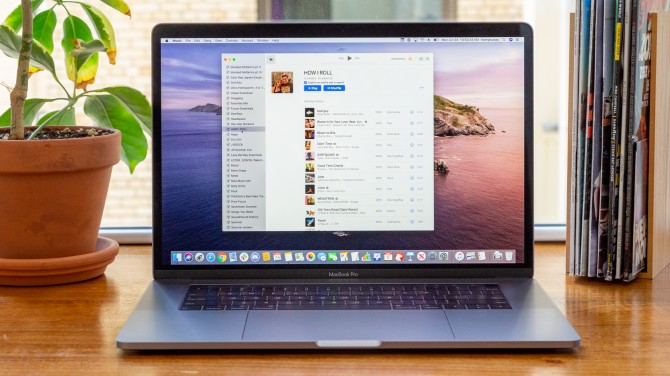macOS Catalina: Features, Release Date, the Death of iTunes
For the next version of its Mac operating software, Apple is coming out of the desert and heading to the sea.
Apple just released macOS Catalina today (Oct. 7). Catalina is highlighted by the breakup of iTunes into three separate apps and the promise of more iOS apps making their way to the Mac.

macOS Catalina availability
Check out our review of the macOS Catalina beta to see if you'll want to install macOS Catalina or just wait. Apple released iOS 13 today, and we've got instructions for how to download iOS 13.
Farewell, iTunes
Even iTunes' most ardent fans — and surely, there are dozens — would have to admit that Apple's music player has gotten bloated over the years, adding all sorts of multimedia and device syncing features on top of its original mission of just managing your music.

Apple's response is to break everything up, with three apps in macOS Catalina taking over for iTunes. The new Music app will focus almost entirely on music playback, with Apple's Craig Federighi describing the new app as "blazingly fast." Apple Music subscribers will be able to get personalized recommendations from within the app.
Stay in the know with Laptop Mag
Get our in-depth reviews, helpful tips, great deals, and the biggest news stories delivered to your inbox.
As for syncing your device, that now takes lace in the Finder, where your iPhone or iPad will appear as just another drive you've plugged into your Mac. Apple envisions the process taking place in the background, but you'll be able to drag songs, podcasts and other media over from Apple's apps onto your mobile device.
MORE: macOS Catalina Beta Hands-on Review: Should You Upgrade Now?
The other remnants of iTunes can be found in the new Podcasts and TV apps, which will work a lot like they do on iOS devices. Podcasts will play back your favorite audio shows, and a new machine-learning powered feature will be able to search for spoken content, so you can search for episodes using words and phrases that appear in the podcasts themselves.
As for the new TV app, it will give Mac user access to the Watch Now and Apple Channels features already enjoyed by iOS users on their version of the TV app. Newer Macs will be able to enjoy 4K HDR playback with HDR10 and Dolby Vision support.
Project Catalyst
At last year's WWDC, Apple announced plans to make it easier for app makers to bring their software over to the Mac, with macOS Mojave showing how it's done with apps like Apple's own News offering. The other show dropped at this year's developer conference, with app makers now gaining access to what Apple calls Project Catalyst.

Project Catalyst is aimed at bringing iPad apps over to the Mac, and there are more than 1 million of those, according to Federighi. The feature will be available through Apple's Xcode developer tools.
Apple says that apps like Twitter, Asphalt 9 and Jira Cloud are already taking advantage of Project Catalyst to produce Mac versions.
Sidecar
If you're the kind of person who likes dual-display setups to get more work done, macOS Catalina is adding a feature that should interest you, especially if you use one of Apple's laptops. The updated OS adds a feature called Sidecar that will let you turn your iPad into a second display.

With Sidecar, you'll even be able to use an Apple Pencil on iPad that support that input device to control and interact with apps on your Mac via that secondary screen.
Accessibility

macOS Catalina boosts the accessibility features on the Mac by adding voice control, with similar support coming to iOS devices this fall. In a demo video, Apple executives showed off how voice controls can halde everything from dictation to navigation. The feature will even add numbers to files and photos so that you can select them with your voice.
Improved security
While macOS Catalina splits up iTunes, it's combining two other apps — Find My iPhone and Find My Friends. (As with the accessibility improvements, this enhancement is headed to iOS devices as well, with iOS 13.) The new Find My feature will be your one-stop location tracking app for keeping tabs on your friends and assorted Apple devices.
One new twist involves the ability to find devices even if they're offline — particularly important if you've lost your MacBook Pro, and it's asleep. Apple devices will now use secure Bluetooth beacon technology so that they're detected by other nearby Mac users who are online. That encrypted location data will be anonymously forwarded to you so that you can find that offline laptop. As described by Apple, the process sounds a lot like the technology that leading key trackers use to pinpoint the location of missing items by crowd-sourcing the location information.

New Macs with T2 security chips add a new Activation Lock feature in macOS Catalina that require your login information to re-active a stolen or misplaced laptop. That essentially makes your computer useless to a thief, Apple says.
Other system app improvements
Look for other apps to gain new features in macOS Catalina, though Apple breezed through the changes during today's keynote. Photos gets a new browsing experience similar to the one slated for iOS 13, while the Notes app gains a new gallery view. Apple is completely redesigning Reminders for the Mac as well.

Another app making the leap from iOS devices to the Mac is Screen Time, which makes its Mac debut in macOS Catalina. Expect the same features like time limits to make their way to the Mac, with those limits enforced across all your Apple devices.
Editors' Note: This story has been updated to correct information about how syncing will be handled post-iTunes.
